In February I moved from Washington to Texas. My 650-pound safe didn’t. The cost and complication just wasn’t worth it. The rental house we would be moving into, sight unseen, has no garage. And I didn’t even know if the safe would make it through the front door. Plus, the idea was renting temporarily while we learn our new stomping grounds and shop for a home to buy. What to do, what to do?
I didn’t want a storage locker — a steel cabinet hardly more “safe” than a lunchbox. I didn’t want a traditional safe, as I wasn’t about to make permanent changes to the house we’re renting and I knew I’d be packing up and moving some time in the near future anyway.
Leaving another safe behind wasn’t an appealing proposition either (and I assume the landlord wouldn’t be pleased). So, in the end, the choice was clear . . .
Less than a week after ordering, the SnapSafe Super Titan XL ($1,869 shipped to your door at GunSafes.com) arrived, packed flat on a pallet.
SnapSafe specializes in “modular” safes, meaning they’re broken down into various components rather than welded together into a monolithic unit, as is the norm. This allows the safe to ship as a flat pack. It also allows the end user to carry each manageable size and weight section to the final assembly area.
Dropped off near my front door, the crate was a bit…daunting. I knew there was a 623-pound safe in there somewhere and the wife and kids were out for the day and unavailable to help.
With the top removed, I was glad to be greeted by an instruction manual. Looking through the assembly process helped me plan out my next moves.
Layer by well-protected layer, I removed components from the packaging and organized them in my office based on their assembly order.
The most difficult part, working by myself, was removing the door from the front wall. For one person these two components are simply too heavy to carry while assembled together. Don’t get me wrong, the actual disassembly is extremely simple, it’s just the weight and logistics make it hard.
Even out of the front wall, the door itself weighs a hefty 92 lbs. I can lift it and carry it, sure, but it was easier to slide it into my office. Basically, I carried it through the front door, set it on a small rug, and slid it the rest of the way.
Likewise, the rear wall — lacking the empty door hole like the front wall and formed from 9-gauge steel as all of the exterior walls are — is a very heavy 140 pounds. This I actually “rolled” carefully, side-bottom-side-top-etc., until it was on that same rug then slid it to the office. Can I pick it up? Yes, though the size and shape make it more difficult than lifting 140 pounds of person or free weights.
With everything in the office, it was time to start assembly. Not only did the SnapSafe include all of the necessary [high-grade] hardware, as you’d certainly expect, but it came with useful tools. Like, a real socket wrench of decent quality.
Will it actually fit into that 23-1/4″ wide (narrow) closet door frame? I had my doubts.
Removing the closet door to provide extra clearance, all components made it through. Though a SnapSafe is easier to assemble laid flat on its back, this wasn’t an option for me in the confines of a small closet so I built it upright.
The process is really quite simple: sides, bottom, and top are supposed to be assembled together then laid on top of the rear wall. Pre-installed bolts in certain walls slot into holes in other walls. Washers and nuts are added by the assembler to hold everything together. Naturally, all of this hardware is completely internal and not visible or accessible from the outside of the safe.
The key was refraining from tightening down any of the nuts until all of the walls were in position — all bolts through all holes.
Next up was inserting the fire protection sheets into all of the walls (the rear was already done). This ceramic fiber material plus the magnesium oxide interior panels help achieve SnapSafe’s claimed 2,300° for one hour “Fire Shield” protection rating. Heat-activated, expanding door seals further protect from heat, smoke, and water.
Next up is installing those interior panels. Follow instructions, as the order and manner in which they’re inserted is crucial if you expect to actually get them in.
Two basic shelf configurations are possible with the included components: a long gun-centric layout or a half long gun, half smaller shelves layout. The heights of the shelves is up to you, except in the half-half configuration where the “T” part must be installed as pictured.
I chose to slide the safe against the left closet wall, providing me with the most door opening space possible. I’d get a couple more inches of door swing by removing two of the three deadbolt handles, which are the first part to contact the closet door frame, but I’m plenty happy as-is.
Done! It took about 90 minutes once I started assembling. It would have taken half that time if I had done it as suggested with the safe laying on the floor. Then again, it couldn’t have pulled a Houdini and magically appeared inside an impossibly small closet.
Seriously, it looks like the safe came first and the house was built around it. It’s instantly obvious to even a casual observer that it would be completely impossible to get the Super Titan XL in there without at least some significant framing and drywall work. From the front at least, there’s zero indication that this is a “modular” safe.
I have also decided not to bolt the safe down. While the safe’s floor has four holes for this purpose, the fact that I’m in a rental house combined with the fact that a burglar would have to do some serious wall demolition work before freeing the 700 lb (with contents) beast makes me comfortable leaving it as-is.
My initial crop of rifles installed just fine. I found the spacing of the rifle rack shelf to be spot-on perfect. Obviously some rifle bolts may have to be removed (mine all fit if strategically left open or closed, depending on bolt design and knob location), and some optics will require additional clearance.
Obviously I still need to organize the top shelf. I simply shoved all my requires-safe-storage crap in there. What I’ll do soon is re-purchase some stands and racks from Gun Storage Solutions (I neglected to move mine from my old safe) and store the pistol cases elsewhere. Additionally, regardless of fire rating, it’s a good idea to store important documents in a fire-resistant container (like this small safe or this file safe) inside of your big safe, which I’ll do.
For lighting I went simple but effective: a 3-pack of battery-powered, motion sensor-activated, LED lights (these ones via Amazon). I used the included double-sided tape to stick one to the closet door frame, mounting the other two via their built-in magnets to the shelf rails inside the safe. A piece of stick-on “hook” side Velcro could also be used to attach lights like these to the safe’s fabric interior lining.
I got the Super Titan XL with a mechanical lock. Not really due to any specific preference over the digital lock that’s also offered at the same price, but because I don’t have much of a preference and the digital lock versions were backordered. I suppose there are some advantages to the good ol’ mechanical flavor — no batteries, no worries about EMP or lightning strikes or whatever shorting out the circuitry — but speed ain’t one of ’em.
A lot of owners end up pre-staging the combination. Whether this means dialed to the first number in your three-number series or dialed to the second, few would actually admit to the practice. Considering there are 100 numbers to choose from and the process from the second number to unlocked still involves rotating the dial counter-clockwise past the final number once, then stopping on the final number on its second appearance, then rotating the dial clockwise until it stops, the chances of guessing not only the correct number but the correct process is nigh on impossible.
On theft resistance, this is not the industry’s toughest vault but it’s solid for its size-vs-price category. All body panels are made of 9-gauge steel, which is thicker than many safes costing twice as much. A spring-loaded relocker fires in the event of drill, hammer, or punch attacks (possibly torch, too) to the locking mechanism area, and further locks the bolts in place. This is a safety feature that most budget safes lack.
On the front of the door is what SnapSafe calls a piece of steel plate, rather than more body-thickness sheet metal wrapped around drywall as it the norm in this market. That door plate is 3/16″ thick, which is the equivalent of 7-gauge sheet. Typically we don’t call things “plate” steel until it’s at least a quarter inch (3-gauge). This is one part of the safe that I would like to see beefed up even further, if for no other reason than a thicker edge is harder to get under and pry up. I still like this honest construction more than than rolled sheet metal style, though.
Eight, 1-inch, chrome steel, live locking bolts secure the door to the body. At least they do on the opening side of the door. There’s nothing on the top or bottom, while the hinge side has a full-length loop of 3/16″ plate to wrap around the front body panel. For additional theft protection I’d want to beef up the top, bottom, and hinge side locking systems as well. Actually, the locking bolts need to be longer to offer the protection they look like they should, so add them to the beef-up list, too.
Then again, going through the door is usually the least effective way to get into a safe, and a professional thief is more likely to grind or torch through a wall or through the top. The 9-gauge steel (43% thicker than many safes in the price range) is appreciated there even if it’s still vulnerable to a good angle grinder and some spare time.
Of course, most gun “safes” are really just residential storage containers. I know the comments will be full of reminders to this effect. No, the SnapSafe here is no exception, and a professional burglar would get into it just fine. But it fits the level of protection I need when weighed against the value of my firearms and the amount my homeowner’s insurance will pay for them.
Were it not wedged in my closet, it would look something like that. Of course, the security factor goes way up by limiting a burglar’s ability to get leverage on a pry bar. Heck, my Super Titan XL is completely inaccessible on four of its sides (it’s against the wall on the back, left side, and bottom, with only 7-3/4″ of space on the right), too close to the ceiling to do anything but squat on the top, and the closet door frame blocks a pry bar’s ability to move in the most effective direction.
Everything works exactly as it should, and the Titan XL has been suiting my needs perfectly for a few months now. Plus, I’m really digging the big-safe-in-a-small-closet thing.
Specifications: SnapSafe Super Titan XL
Exterior: 59″H x 38″W x 24″D (add 3″ for handle)
Interior: 53.5″H x 33″W x 20.5″D
Door Opening: 52″H x 14.75″W
Weight: 623 lbs.
Capacity: 36+ Long Guns
Lock: Standard with digital or mechanical. Optional EMP lock for an additional cost.
Fire Rating: 2300°F one-hour Fire Shield protection. Heat activated door fire seals.
Lifetime Warranty
MSRP: $1,999 ($1,869 with free shipping on GunSafes.com)
Ratings (out of five stars):
Fit and Finish * * * *
Nice powdercoat, clean edges, and very good fit between all of the components. If there’s anything I’d improve, it would be a tighter fit between the door and its frame. A smaller gap would make it even harder to get a pry tool in there.
Utility * * * * *
The average homeowner moves every seven years. I have to assume that figure is lower for renters. Moving a big safe is difficult and expensive, but I can (and will) move this one myself. I transported it and assembled it inside of my tiny office closet by myself, after all. Yet it still offers the fire and theft protection of a typical welded-construction residential gun safe, if not more than most of the competition in its general price range (apologies, I won’t be destructive testing it).
Customize This * * * *
It isn’t the most configurable safe in the world, but it does come out of the box with multiple interior configuration options.
Overall * * * *
The utility is through the roof. It’s exactly what I wanted and needed. I’d give it five stars if the door and door frame were beefed up a little more.

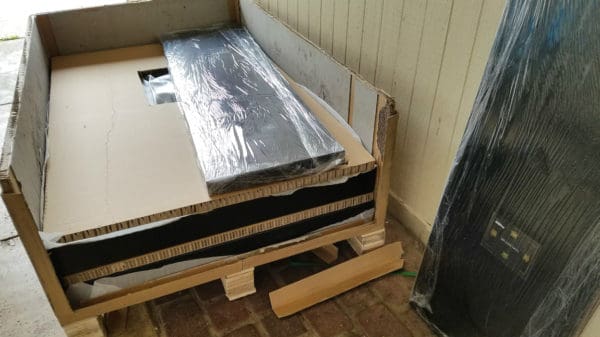
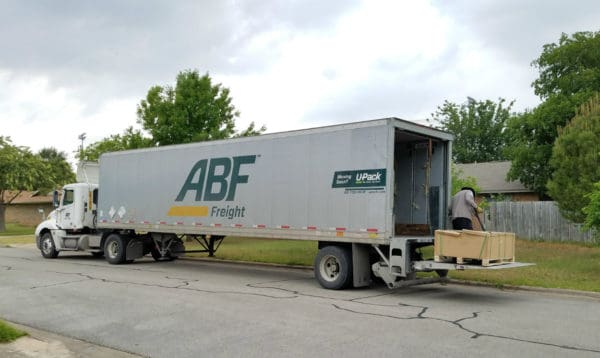
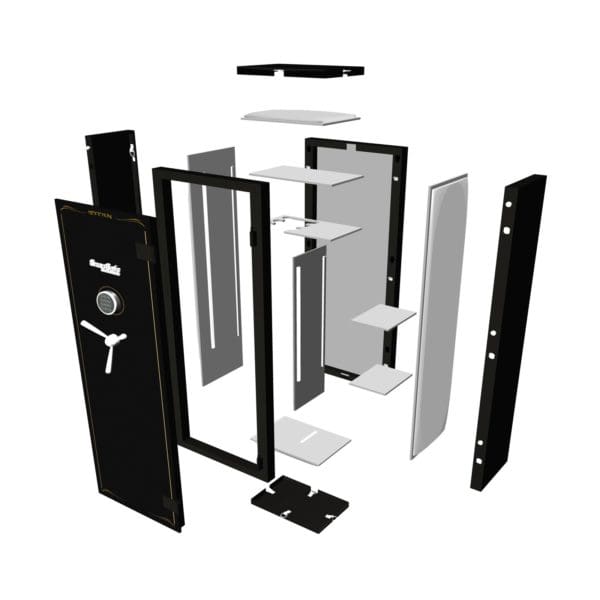
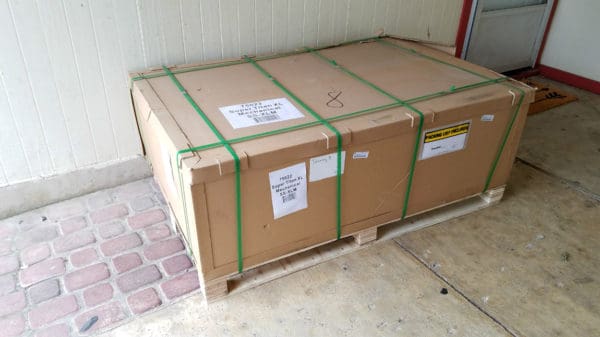
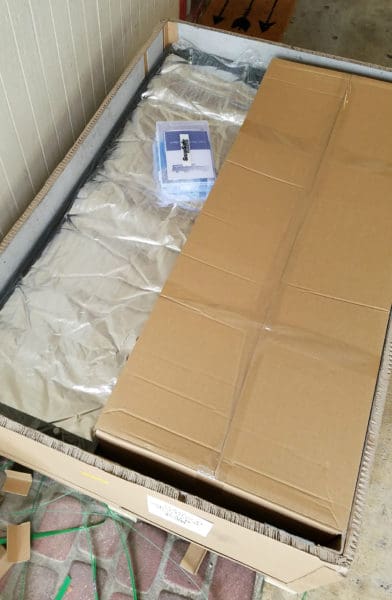

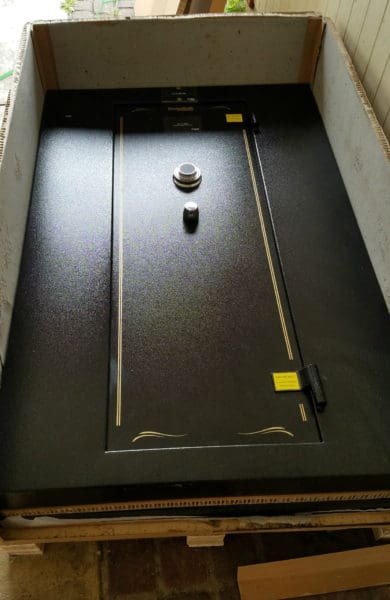
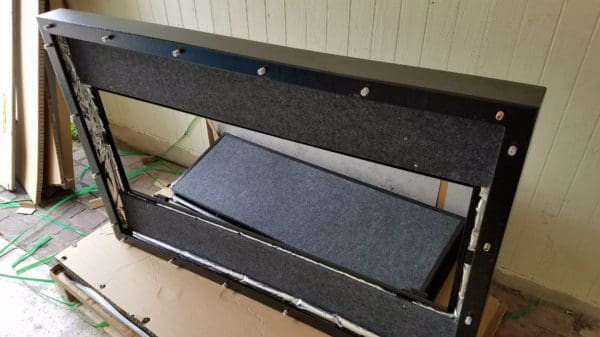
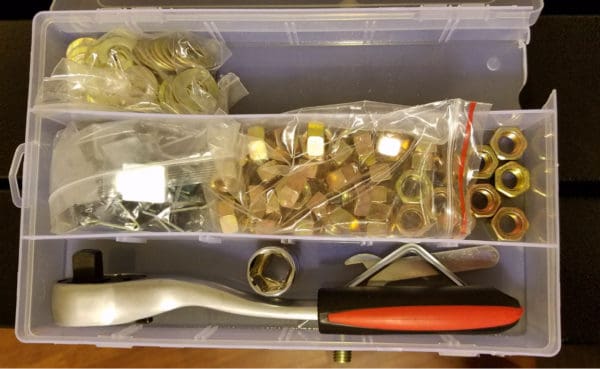
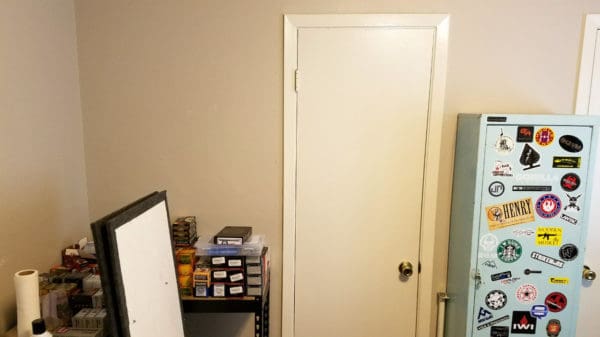
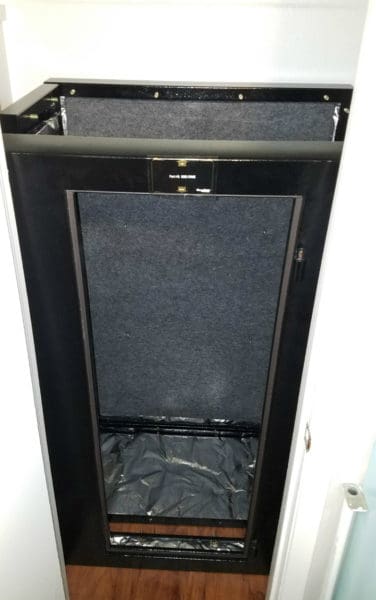
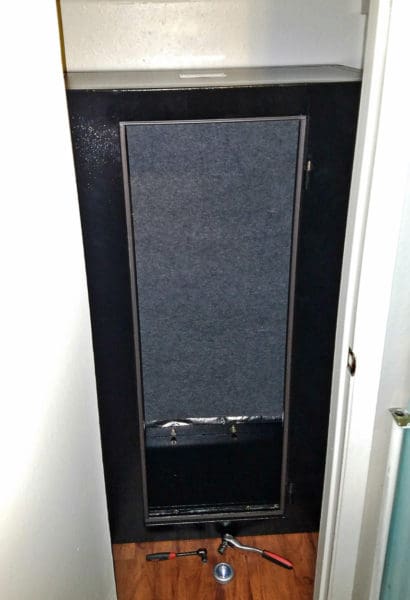

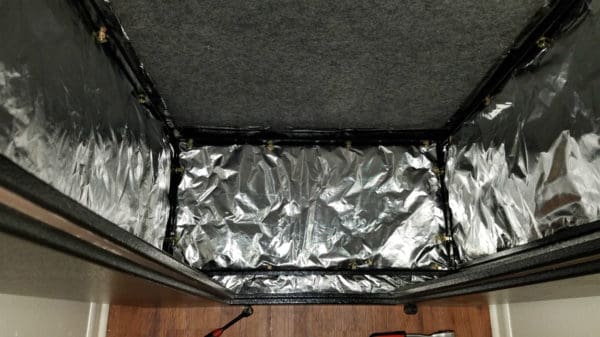
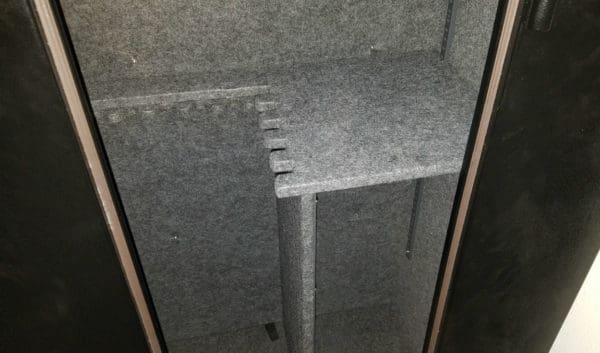
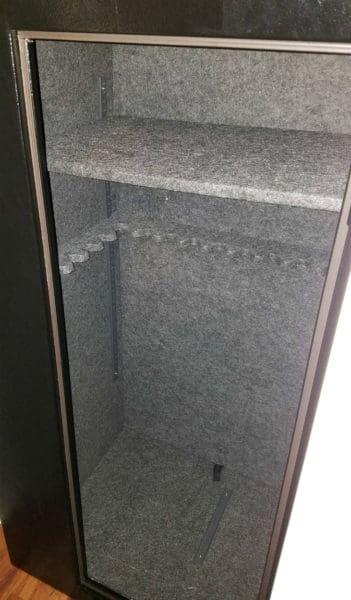
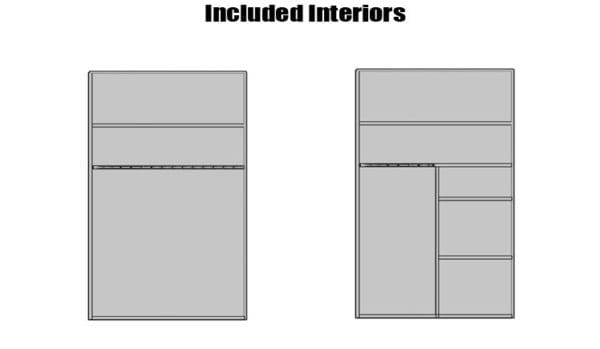
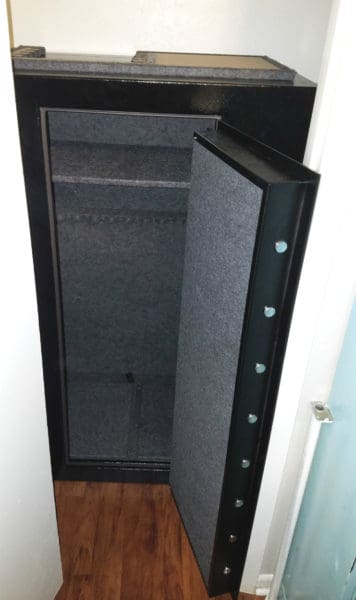
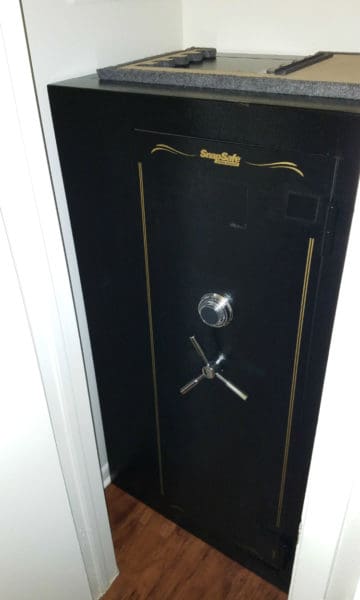
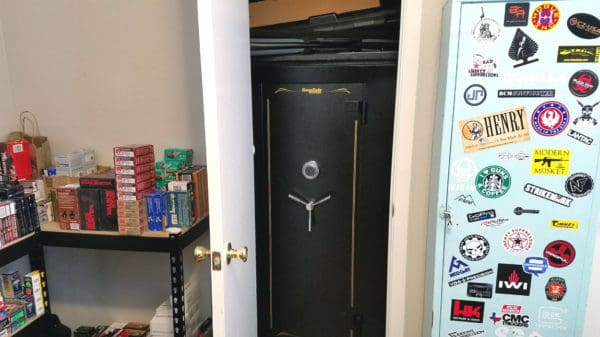
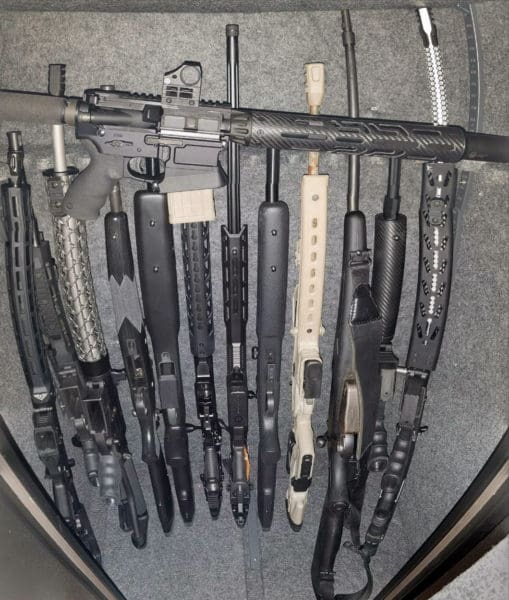
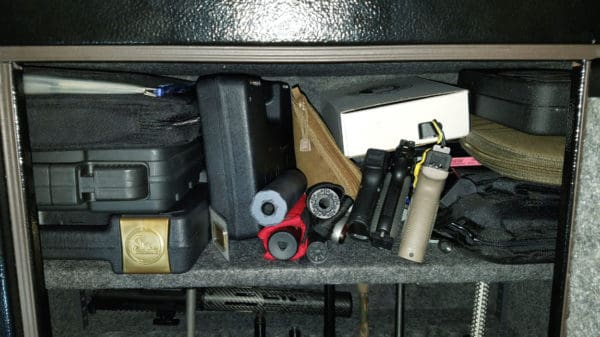

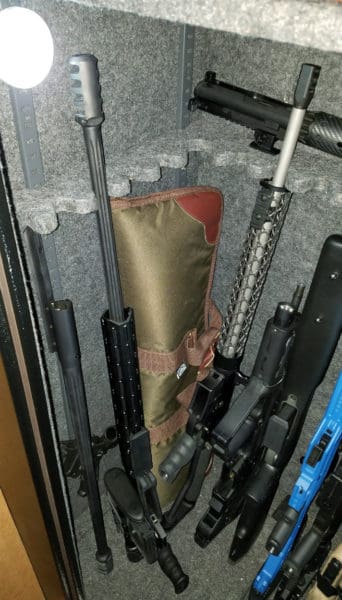
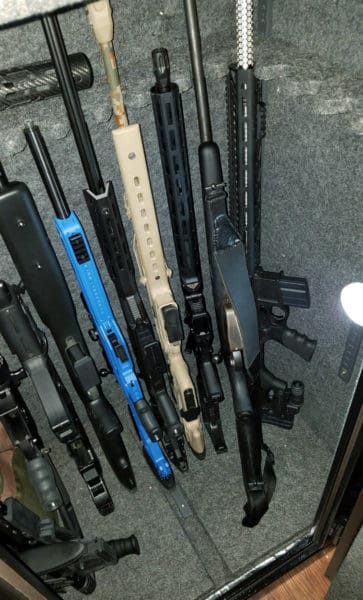
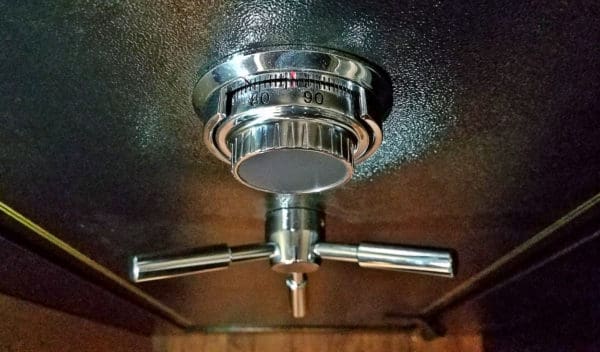

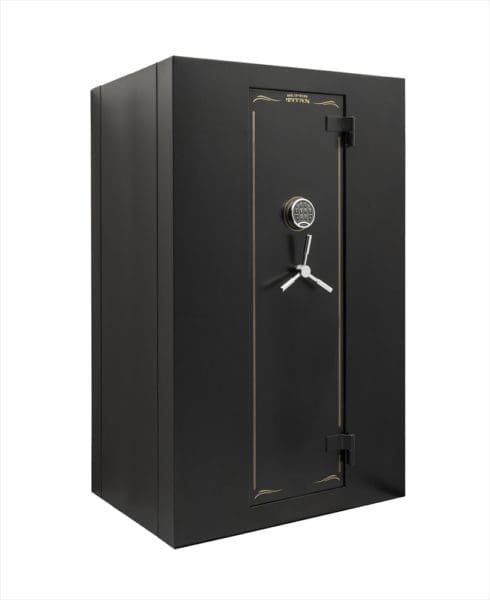



Awesome review — thank you for it! I appreciate the same things about it that you do – namely the ability to shoe-horn it into a small closet and give it the appearance of a “built-in”! The film-noir buff in me would put built-in bookshelves around it, with a swing-out set over the doorway, but I realize you’re renting!
All in all, a nice review of something that would be of use to everyone who owns multiple firearms. I’ve bookmarked the company’s website for further research & use myself!
Ok, nice safe, but seems very expensive? Is it a sponsored event? Not judging, the problem did need an applicable fit, and applicable fits have to give somewhere and it’s most often price.
Q: Did what you have to do to “put it together” pre-empt you from taking it apart and doing it again? i.e., DO YOU TEAR UP ANYTHING THAT WOULD HAVE TO BE REPLACED BEFORE RE-ASSEMBLY?
Nice reloading area.
You can go really really cheap and get a safe at Costco or something in this size range for like $800. I think the quality here is a bit better, but, yes, ultimately you’re paying some premium for the modularity. If I move once I’m coming out ahead, though, vs. leaving my old safe behind and basically breaking even vs. paying to have my old safe moved. In this case, I’ll be moving it myself without too much difficulty. And I love that I can put it almost anywhere. I’ll plan on assembling it in another closet when we find our next home.
And, no, none of the assembly is in any way permanent. Just nuts on top of bolts. It’ll disassemble and reassemble many times over without issue or degradation. My biggest concern would be the interior wall panels, which are like a magnesium oxide version of sheet rock so it’s possible to break/crack them. You can get individual replacements, but obviously I’d rather not.
And I’d like if that was a reloading area but it’s actually just shelves and shelves of factory loaded ammo. There’s probably as many pounds of ammo in my office as there are pounds of filled gun safe 😉
Ya, that’s what I mean, there’s modular ‘once and done [solid]’ and that’s great, but if it’s modular [once and done but moveable for 2nd or 3rd time and done] (without tearing up (~excessive wear and tear) the fire-protection, and walls) is much more worth the money.
You did the right thing when you avoided the electronic lock. They are not as reliable over many years like the mechanical locks.
You also ended up with a much better RSC than the $700 Costco. As you noted, the Snap Safe is made of a much heavier gauge steel. It is also very secure where you installed it. The quickest way into a thin gauge RSC is to flop it face down and chop it open with a fire axe or similar tool. This is pretty much impossible where you put yours.
Great review, I have no want for this item but if I did I would trust this review. You are my favorite reviewer on this site, keep it up.
Seriously, mom, you gotta stop making fake names and commenting with this crap.
LOL!
Agreed Jeremy. Keep it coming. Oh wait, keep Dean’s nose to the writing grindstone as well.
There’s no COSTCO or any safe with 7 gauge steel on door and 9 gauge on sides for $800, or $1,500.
You’re lucky if you get 10 gauge steel door and 12 gauge for body under $999.
My bad, that’s ammo, it almost looked like Hornady and other dies, etc.
Great review! Thank you for documenting this. I have a similar question as Joe R. Do you feel comfortable with the safe structure enough to take it apart again, move it and then put it all together.
Yes, many times. See my reply to Joe for more details.
What is supporting the floor of your closet? I’d hope that lump is on good sized joists and at a outside foundation wall. Your landlord would not like that in the basement.
Ya, I think you really are always better off on a slab.
Wait, not you, your safe.
LOL Joe.
neiowa — There are no basements in the Austin area. This is a single floor home on a concrete slab. The safe is on cheap linoleum flooring, which I’m pretty sure is right on top of the concrete.
“Ya, I think you really are always better off on a slab.
Wait, not you, your safe.”
As long as Jeremy’s wife agrees, he agrees. 😉
The re-locker is a nice touch, I admit…
I was in the exact same situation when I relocated from San Diego to DFW. My guns, reloading gear, ammo and so on made the trip out, my safe did not. Sold it locally on Calguns.net and stored my guns in my buddy’s office/spare bedroom/man cave while I was getting situated.
I wish I’d known about this system when I got my apartment. I ended up with a 25 gun Superior that was the biggest thing I could fit through the doorjambs and into my bedroom closet, and now bolted securely to the garage floor at my new place. C’est la vie.
+++ This ^
Apartment and stairs (or worse narrow stairs with a switch back) you might go with a 4 gun StackOn.
I remember when those Stack-Ons were about $100.
They are about $300 now.
The safe I paid about $750 (delivered) for is now about $2100. And it’s almost full of guns and stuff.
I think the typical residential burglary threat is a couple of punk teens on bikes armed with a heavy duty screw driver or small pry bar. They crawl through a window looking to snatch any lose money, jewelry or pills. They aren’t equipped to cart off long guns or tear open a steel locker. Adult home invasion gangs are a bigger problem, even a safe won’t stop them because they’ll torture the hostages to get the combination, they have all the time in the world.
Looks pretty good and pretty large for that small closet area I think you picked a winner. I have a Holland 22 gun Republic model. It has a quarter inch steel plate on the front of the door like you were wanting but it is not modular I believe the weight of the safe is 700 lb. And the door is like five inches thick if not thicker it’s pretty gigantic and it’s got inch and a half Chrome deadbolts on top and bottom left and right side of the door. And I believe they’re right around the same price for my 22 gun safe versus you’re bigger safe I think you’re safe as a little bit wider but it looks great man.
I love safe porn.
Ok, now do pics with the room lights off but the safe lights on.
: )
Seriously, thanks for all the pics, it’s a lot better to see it in stages.
/snorts!
“Ok, now do pics with the room lights off but the safe lights on.”
Done 🙂 : http://www.thetruthaboutguns.com/wp-content/uploads/2017/08/safe_porn.jpg
It’s good that the modular technology is proven. They make whole saferooms out of the stuff. AND THEY TYPICALLY USE 7 GUAGE STEEL
I checked.
(and I would say yes, 9 guage is better).
7 gauge is thicker than 9 gauge.
Thank you, yes, thanks for setting me straight
In the inverse though, I’ve seen (held the safe room materials and panels in my hand at Hasty Bake in Tulsa https://www.hastybake.com/) I would think that those panels minus 0.0298″ [7 @ 0.1793″ – 9 @ 0.1495″] are still extremely substantial.
If they were any heavier, they would lose the definition of modular, because they’d be too heavy to maneuver the panel pieces.
Pretty neat.
My second safe is a fat boy. (Had too many guns NOT in a safe.)
Then inherited Dad’s. So, unfortunately I have to buy more guns to fill that one.
Just picked up a beautiful SxS in 28 gauge.
I like the 9 gauge steel, not too bad, but yeah, Snapsafe should have used at least a 1/4″ door. Is this a UL listed lock? Anyway, I’m curious what the bolt work looks like on this. Can you remove the panel on the door and snap some pics of the bolt work? A lot of “cheap” safes, like the ones Costco and other big box stores sell, have thick steel bolts that are simply bolted to a thin angle piece with 1/4″ nuts and bolts providing a low level of support. They give the appearance of being strong by stating the number and size of the bolts, but if the work behind the panel is cheap, then that’s the level of protection those big bolts are actually going to offer. A high number of bolts are also needed to make up for a thin or weak door.
The locks are UL listed. The safe as a whole, though, does not appear to have a UL burglary rating. I’d say one of the reasons for that is what you mentioned: short bolts that are visually impressive but mostly theater (attracts buyers like a fancy fishing lure haha), as what’s on the inside doesn’t back that up. Which I mentioned in the review when I said, “the locking bolts need to be longer to offer the protection they look like they should.” They’re basically peened into a flare on the back side of the anti-pry plate rather than attached with a puny 1/4″ bolt like most budget safes, as you mentioned. The piece that they’re affixed to isn’t anything crazy but it’s better than the cheap, thin angle iron on most. It isn’t just a 90* bent piece of thin sheet, but is a full U shape of thicker material with better anti-pry reinforcement. But I still wish the bolts were long enough to provide their own anti-pry reinforcement.
Great article/review.
Thank you for posting — very informative.
I just received and assembled the small SnapSafe Titan on Wednesday. I am very happy with it.
As other comments have mentioned, there are cheaper safes, there are better fire rated safes, there are probably more secure safes available.
However, the small Titan was EXACTLY what I was looking for. Arriving in pieces, I was able to move it up/down stairs myself. I assembled it and it fits precisely in the spot I wanted. The electronic lock is quick to access, lock everything up before I leave for work, open it up quick when I get home. It is not my only safe, so it is reserved for my home defense guns (a few handguns, w/ and w/o lights, pistol/carbines, suppressors, etc…). If/when I go to move to a new house, I can get a buddy to help or dissassemble and move it easily on my own. The interior is nicely felted and adjustable.
A few modifications I am planning, mostly gun mounts on the door. I would like a few handguns on the door to get to quickly. I also am looking for some rubber garage hooks to hold a suppressed sub gun on the door for an easy grab if I need it, should fit within the width of the door with an optic and the magazine in.
I will probably order another (one of the big ones) in the future when I get a little gun room built.
Worth taking a look at if you are wanting/needing a safe.
I bought a Zanotti Armor RSC when I lived in an apartment after I lost a number of guns in a theft.
It is similar to the Snap Safe. The top and bottom are stamped into a tub shape. The sides form maybe a 1″ lip around the edge. Unlike the Snap Safe, the Zanotti is held together with large pins in an arrangement much like large hinges. There are two L shaped pins on each edge and they slide into bosses welded into the body of the RSC.
When I moved I didn’t really disassemble the Zanotti, the movers just lifted off the door, which is the heaviest piece. The body is still heavy, but they were big guys and were able to move it in one piece.
So far I’ve moved twice and I really do need another RSC. I’ve been happy with the Zanotti, but I will be taking a look at the Snap Safe for my next one.
They’re similar in many ways. I’d say the main advantage to the Snap is that they’re available and can be at your place in a few days. The Z are made to order and wait times tend to be 6 to 9 months. They’re also more expensive, though they’re made in the U.S. and the fit and finish is nicer. While I highly doubt the Snap’s stated fire rating, it is actually insulated whereas the Z is not. The steel on the Snap’s walls is thicker, but the doors are both 3/16″. Snap uses the same width door on its safes while Z does larger doors for larger safes. There are positives and negatives to each there. The Z’s assembly is faster and easier, except for sometimes very heavy doors. I’m not familiar with the bolts and locking mechanism in the Z so can’t compare this aspect. It looks like Z generally uses nicer locks, whether electronic or manual, though Snap’s are still UL listed (I believe the manual one is a LaGard type 2 or something). Z has an additional anti-drill plate installed over the locking mechanism, which the Snap doesn’t. I think the Snap relies on its relocker for anti drill protection. And I think it’s the very rare burglar who would drill a safe lock anyway. I know I’d try to knock it over and angle grind or ax a new door in the back and, if it was bolted down, do that on a side wall. Maybe pry the door open instead if it had a decent gap in which I could insert a large wrecker bar and there was clearance in the room to get leverage on it.
“it came with useful tools. Like, a real socket wrench of decent quality.”
At that price, it should come with an impact wrench, attached to a Snap-On Tools calendar girl.
I learned more about what one needs in a good safe in your one review than I ever knew before. Thanks for the great job, Jeremy S. !
Now just spend some money on a monitored alarm and that will mean that someone won’t get enough time to attack it.
When your buy a place consider Sturdy brand safes .
Buy a hand truck. Its seriously one of the best most useful pieces of equipment I have ever bought. Paired with some ratchet straps one can move many very large things all by yourself without destroying your back. Would have made moving the pieces a cinch. Since you’ll be moving again soon it will be really handy, although I haven’t moved in ten years, I still use mine for random stuff about every other week.
Word. Your comment got me to thinking. My hand truck is one of the most used pieces of gear in my garage.
As I get older I get more things with leverage and wheels. Just got a jogging stroller for a decoy wagon on my hunting trips. Decoys aren’t heavy but by the time you factor in weapon, shells, rations and age the wheels come into their own.
Thanks for the review. Really helpful, and pretty detailed. 🙂
Been lovin’ my Zanotti ZA-2 for half a decade now. I don’t think you can beat it.
I recently got the smaller Snapsafe. It’s a good safe, but can be easily and cheaply made more secure. I epoxied some 7/16″ steel bar into both sides of the door channels from top to bottom to make a pry attack much more difficult.
The earlier Snapsafes came with a slip clutch on the handle mechanism, but mine did not, much to the surprise of Snapsafe Tech Support. Apparently, it was a recent, and unannounced modification from the Chinese factory. Mine just has a directly welded linkage, which is vulnerable to extension attacks. What I did was replace the mechanism with a replicated piece made from wood, plastic, and aluminum from the hardware store. The whole piece has three separate parts that would shear during a leverage attack. It was inexpensive but did take quite a bit of time to figure out and design (chalk it up to hobby time).
To reinforce the bolts, I epoxied some 1 ½” long 5/16” Grade 8 bolts into the hollows. The heads of the 5/16” bolts fit perfectly and insert about 3/8” into the hollow. On the threaded end of the bolts I put 1 ¼” washers, with butt up precisely against the steel frame. The configuration extends the bolts to a total of 3 ¾”. Will the epoxy hold under a pry attack? It shouldn’t matter as the epoxy isn’t the point of strength but merely the agent holding the bolt firm – the stress points are the original safe bolts and original safe frame. Even in their unreinforced, factory configuration, the swagged safe bolts are far stronger than the 1/4″ bolt mounting of most other big box store models.
My safe fits so tightly together that except for one section I can’t even get a razor blade in between the seams, and even that one section will take only about ¼” of the tip of a pocket knife. The overall fit and finish is excellent on the metal pieces, but I think the interior was made by a different subcontractor as it’s as cheap and sloppy as something from the dollar store. Once put together, however, it does its job and works fine.
Another mod I’ve been contemplating is compensating for the lack of an anti-drill plate for the lock. There is an open-spaced mounting box between the lock and the front door, and I’ve been considering encasing the top and bottom of that and filling the space with ball bearings. But for now I’ve got other puzzles to solve and hobbies to indulge.
Great review! Many thanks.
Especially interesting are the security improvement you made: (1) the welded linkage replaced with a piece made from wood, plastic, and aluminum from the hardware store; and (2) the bolt heads epoxied into the hollows (the threaded end of the bolts I put 1 ¼” washers, with butt up precisely against the steel frame. …. extends the bolts to a total of 3 ¾”).
** Can you show pictures?
Thanks
Yes pics
In what order did you assemble the parts since you were doing it upright? In your picture with the top not on yet it looks like it’d be impossible to get the top on without pulling the sides/bottom back away/off (at least partially?)
Great review, thanks!
I’ve been looking at the SnapSafe product line for a few months. I just moved and now need to hurry up and decide on which safe to purchase.
I think I can live with the “made in China” status of this safe, although I’m not happy about it. And that it isn’t the most robust safe on the planet, but I wish they had made a few improved decisions. I’ll be moving this safe a few times over the next 5 years so the ability to take it apart and move myself is a big positive.
But I’m worried about the lock. I can’t find any more info online about how this digital lock with a mechanical override key would be robust against attacks on the key. What happens if the override key lock is drilled out, picked, bumped, etc using any of the typical trivial attacks that work on most key locks?
Also I’d like to better understand how this lock will survive EMP, or if SnapSafe has another lock option that is built to survive EMP. It’s unclear if they are referring to an upgraded EMP lock which is not clearly defined in their products or if they are referring to the backup mechanical key lock attached to the normal digital lock.
Anyone able to add more details on the digital lock options from SnapSafe?
Thanks
They use locks from SecuRAM: https://www.securamsys.com/
Actually, my Ruger Super Titan comes with an Intellok. I cant figure out who makes it.
I believe they are made in China. I would have considered one but boycotting China is more important
SNAPSAFE MADE SOME CHANGES.
I liked the review but Snapsafe Made some changes for the worse.
1. No 9 gauge steel but two layers of 14 gauge they call 9 gauge.
2. Cut 73 pounds somewhere
3. No manual lock available.
4. Safe comes predrilled for the burglar so you can unlock it with a skeleton key as a “Backup”
5. This container is now around $3,000
I guess it’s better than nothing.
Comments are closed.